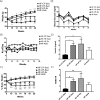A ketogenic diet reduces metabolic syndrome-induced allodynia and promotes peripheral nerve growth in mice
- PMID: 29763602
- PMCID: PMC5994385
- DOI: 10.1016/j.expneurol.2018.05.011
A ketogenic diet reduces metabolic syndrome-induced allodynia and promotes peripheral nerve growth in mice
Abstract
Current experiments investigated whether a ketogenic diet impacts neuropathy associated with obesity and prediabetes. Mice challenged with a ketogenic diet were compared to mice fed a high-fat diet or a high-fat diet plus exercise. Additionally, an intervention switching to a ketogenic diet following 8 weeks of high-fat diet was performed to compare how a control diet, exercise, or a ketogenic diet affects metabolic syndrome-induced neural complications. When challenged with a ketogenic diet, mice had reduced bodyweight and fat mass compared to high-fat-fed mice, and were similar to exercised, high-fat-fed mice. High-fat-fed, exercised and ketogenic-fed mice had mildly elevated blood glucose; conversely, ketogenic diet-fed mice were unique in having reduced serum insulin levels. Ketogenic diet-fed mice never developed mechanical allodynia contrary to mice fed a high-fat diet. Ketogenic diet fed mice also had increased epidermal axon density compared all other groups. When a ketogenic diet was used as an intervention, a ketogenic diet was unable to reverse high-fat fed-induced metabolic changes but was able to significantly reverse a high-fat diet-induced mechanical allodynia. As an intervention, a ketogenic diet also increased epidermal axon density. In vitro studies revealed increased neurite outgrowth in sensory neurons from mice fed a ketogenic diet and in neurons from normal diet-fed mice given ketone bodies in the culture medium. These results suggest a ketogenic diet can prevent certain complications of prediabetes and provides significant benefits to peripheral axons and sensory dysfunction.
Keywords: DRG; Diabetes; Exercise; High-fat; Ketogenic; Ketones; Mice; Pain.
Published by Elsevier Inc.
Figures







Similar articles
-
Reduced mitochondrial reactive oxygen species production in peripheral nerves of mice fed a ketogenic diet.Exp Physiol. 2018 Sep;103(9):1206-1212. doi: 10.1113/EP087083. Epub 2018 Aug 8. Exp Physiol. 2018. PMID: 30088302 Free PMC article.
-
A ketogenic diet reduces mechanical allodynia and improves epidermal innervation in diabetic mice.Pain. 2022 Apr 1;163(4):682-689. doi: 10.1097/j.pain.0000000000002401. Pain. 2022. PMID: 34252910 Free PMC article.
-
Modulation of diet-induced mechanical allodynia by metabolic parameters and inflammation.J Peripher Nerv Syst. 2017 Mar;22(1):39-46. doi: 10.1111/jns.12199. J Peripher Nerv Syst. 2017. PMID: 27935216 Free PMC article.
-
Nutritional Ketosis for Weight Management and Reversal of Metabolic Syndrome.Curr Nutr Rep. 2018 Sep;7(3):97-106. doi: 10.1007/s13668-018-0235-0. Curr Nutr Rep. 2018. PMID: 30128963 Free PMC article. Review.
-
Ketogenic diets and protective mechanisms in epilepsy, metabolic disorders, cancer, neuronal loss, and muscle and nerve degeneration.J Food Biochem. 2020 Mar;44(3):e13140. doi: 10.1111/jfbc.13140. Epub 2020 Jan 14. J Food Biochem. 2020. PMID: 31943235 Review.
Cited by
-
Low-Carbohydrate High-Fat Diet: A SWOC Analysis.Metabolites. 2022 Nov 17;12(11):1126. doi: 10.3390/metabo12111126. Metabolites. 2022. PMID: 36422267 Free PMC article. Review.
-
Advances in diet-induced rodent models of metabolically acquired peripheral neuropathy.Dis Model Mech. 2021 Nov 1;14(11):dmm049337. doi: 10.1242/dmm.049337. Epub 2021 Nov 11. Dis Model Mech. 2021. PMID: 34762126 Free PMC article.
-
Low-Carbohydrate and Very-Low-Carbohydrate Diets in Patients With Diabetes.Diabetes Spectr. 2020 May;33(2):133-142. doi: 10.2337/ds19-0070. Diabetes Spectr. 2020. PMID: 32425450 Free PMC article.
-
The Aneugenicity of Ketone Bodies in Colon Epithelial Cells Is Mediated by Microtubule Hyperacetylation and Is Blocked by Resveratrol.Int J Mol Sci. 2021 Aug 30;22(17):9397. doi: 10.3390/ijms22179397. Int J Mol Sci. 2021. PMID: 34502304 Free PMC article.
-
Abnormal intraepidermal nerve fiber density in disease: A scoping review.Front Neurol. 2023 Apr 20;14:1161077. doi: 10.3389/fneur.2023.1161077. eCollection 2023. Front Neurol. 2023. PMID: 37153658 Free PMC article.
References
-
- Blacklock AD, Johnson MS, Krizsan-Agbas D, Smith PG. Estrogen increases sensory nociceptor neuritogenesis in vitro by a direct, nerve growth factor-independent mechanism. The European journal of neuroscience. 2005;21:2320–2328. - PubMed
-
- Calcutt NA, Smith DR, Frizzi K, Sabbir MG, Chowdhury SK, Mixcoatl-Zecuatl T, Saleh A, Muttalib N, Van der Ploeg R, Ochoa J, Gopaul A, Tessler L, Wess J, Jolivalt CG, Fernyhough P. Selective antagonism of muscarinic receptors is neuroprotective in peripheral neuropathy. The Journal of clinical investigation. 2017;127:608–622. - PMC - PubMed
Publication types
MeSH terms
Substances
Grants and funding
LinkOut - more resources
Full Text Sources
Other Literature Sources
Medical
Research Materials

